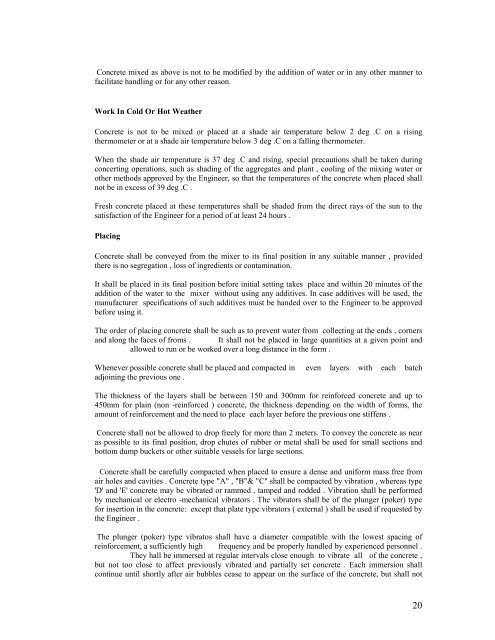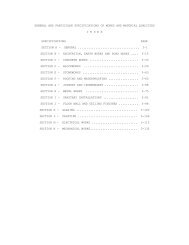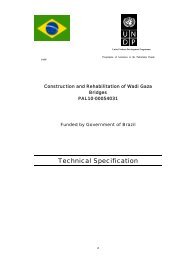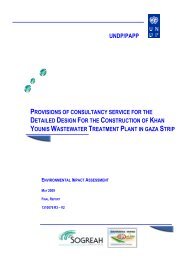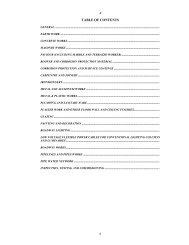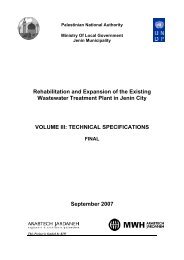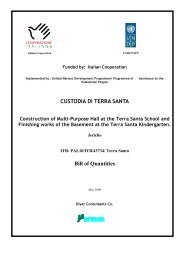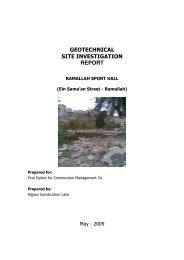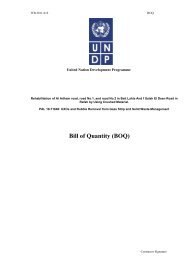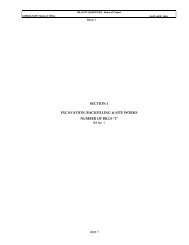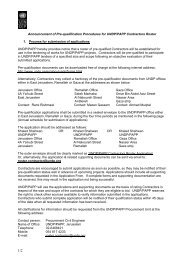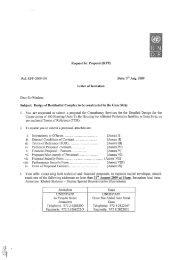Technical Specifications - UNDP
Technical Specifications - UNDP
Technical Specifications - UNDP
You also want an ePaper? Increase the reach of your titles
YUMPU automatically turns print PDFs into web optimized ePapers that Google loves.
Concrete mixed as above is not to be modified by the addition of water or in any other manner to<br />
facilitate handling or for any other reason.<br />
Work In Cold Or Hot Weather<br />
Concrete is not to be mixed or placed at a shade air temperature below 2 deg .C on a rising<br />
thermometer or at a shade air temperature below 3 deg .C on a falling thermometer.<br />
When the shade air temperature is 37 deg .C and rising, special precautions shall be taken during<br />
concerting operations, such as shading of the aggregates and plant , cooling of the mixing water or<br />
other methods approved by the Engineer, so that the temperatures of the concrete when placed shall<br />
not be in excess of 39 deg .C .<br />
Fresh concrete placed at these temperatures shall be shaded from the direct rays of the sun to the<br />
satisfaction of the Engineer for a period of at least 24 hours .<br />
Placing<br />
Concrete shall be conveyed from the mixer to its final position in any suitable manner , provided<br />
there is no segregation , loss of ingredients or contamination.<br />
It shall be placed in its final position before initial setting takes place and within 20 minutes of the<br />
addition of the water to the mixer without using any additives. In case additives will be used, the<br />
manufacturer specifications of such additives must be handed over to the Engineer to be approved<br />
before using it.<br />
The order of placing concrete shall be such as to prevent water from collecting at the ends , corners<br />
and along the faces of froms . It shall not be placed in large quantities at a given point and<br />
allowed to run or be worked over a long distance in the form .<br />
Whenever possible concrete shall be placed and compacted in even layers with each batch<br />
adjoining the previous one .<br />
The thickness of the layers shall be between 150 and 300mm for reinforced concrete and up to<br />
450mm for plain (non -reinforced ) concrete, the thickness depending on the width of forms, the<br />
amount of reinforcement and the need to place each layer before the previous one stiffens .<br />
Concrete shall not be allowed to drop freely for more than 2 meters. To convey the concrete as near<br />
as possible to its final position, drop chutes of rubber or metal shall be used for small sections and<br />
bottom dump buckets or other suitable vessels for large sections.<br />
Concrete shall be carefully compacted when placed to ensure a dense and uniform mass free from<br />
air holes and cavities . Concrete type "A" , "B"& "C" shall be compacted by vibration , whereas type<br />
'D' and 'E' concrete may be vibrated or rammed , tamped and rodded . Vibration shall be performed<br />
by mechanical or electro -mechanical vibrators . The vibrators shall be of the plunger (poker) type<br />
for insertion in the concrete: except that plate type vibrators ( external ) shall be used if requested by<br />
the Engineer .<br />
The plunger (poker) type vibratos shall have a diameter compatible with the lowest spacing of<br />
reinforcement, a sufficiently high frequency and be properly handled by experienced personnel .<br />
They hall be immersed at regular intervals close enough to vibrate all of the concrete ,<br />
but not too close to affect previously vibrated and partially set concrete . Each immersion shall<br />
continue until shortly after air bubbles cease to appear on the surface of the concrete, but shall not<br />
20


